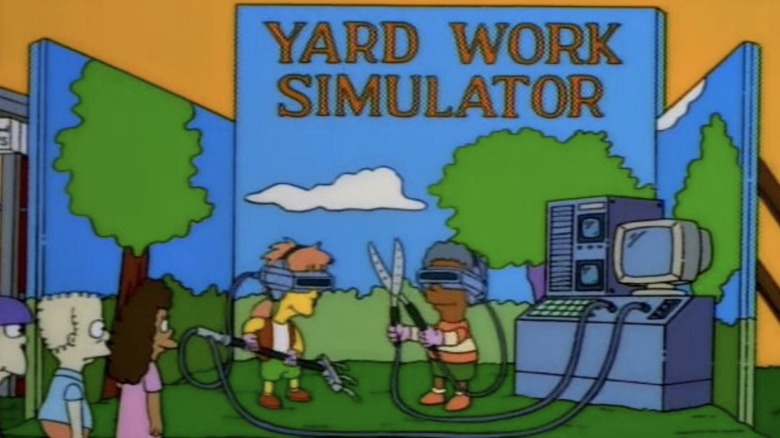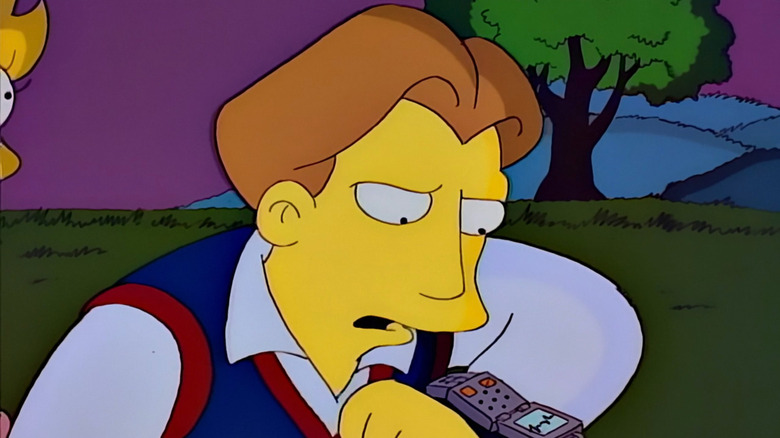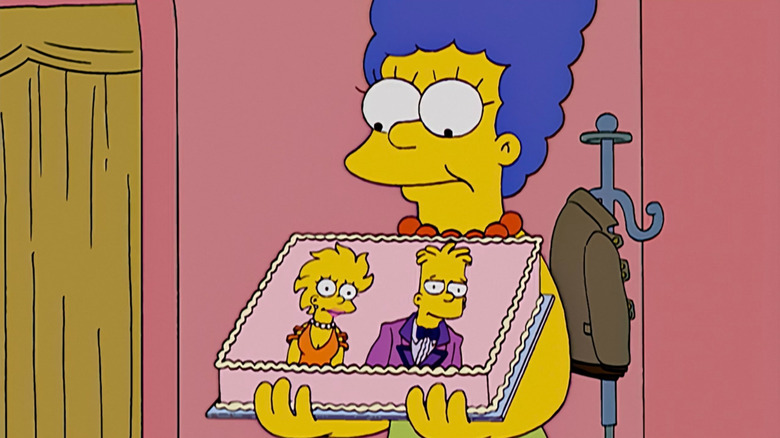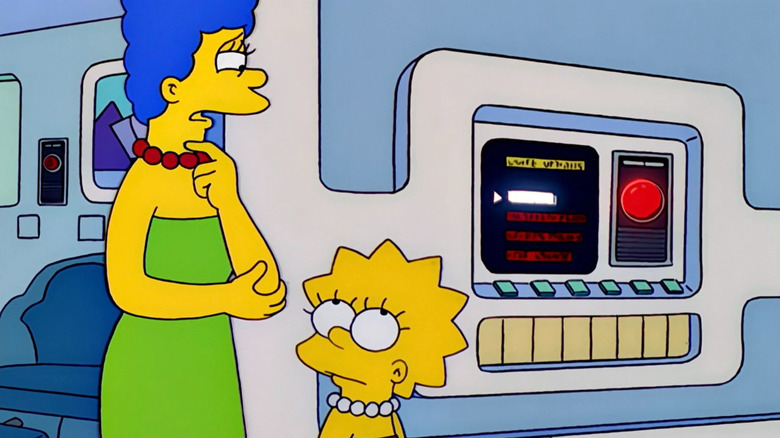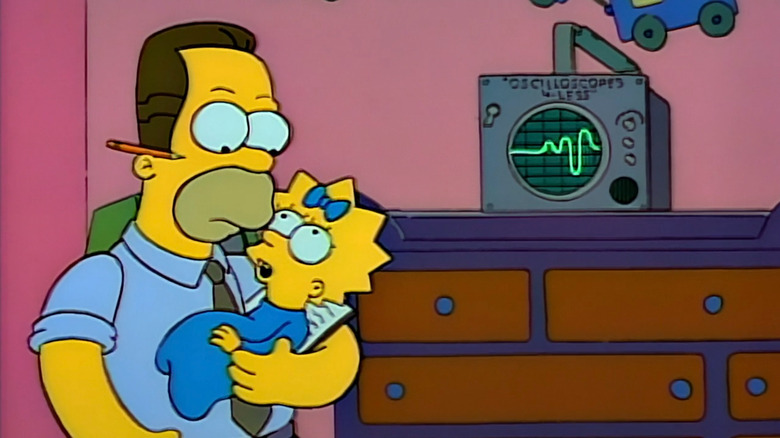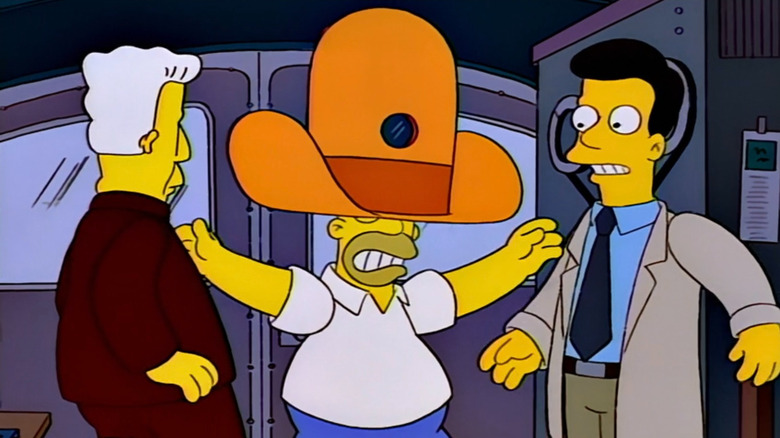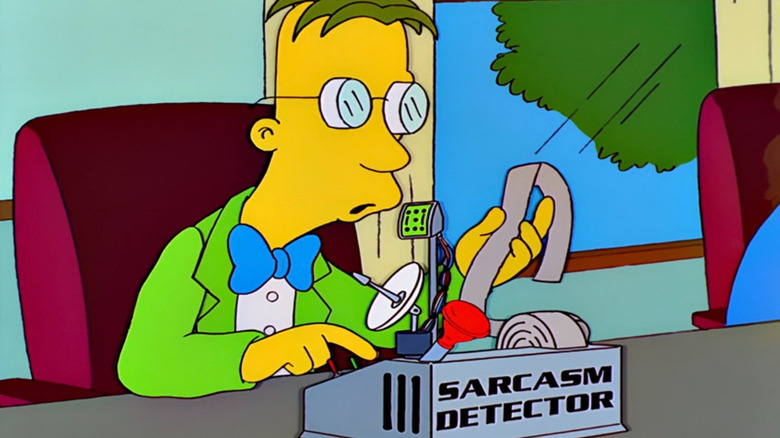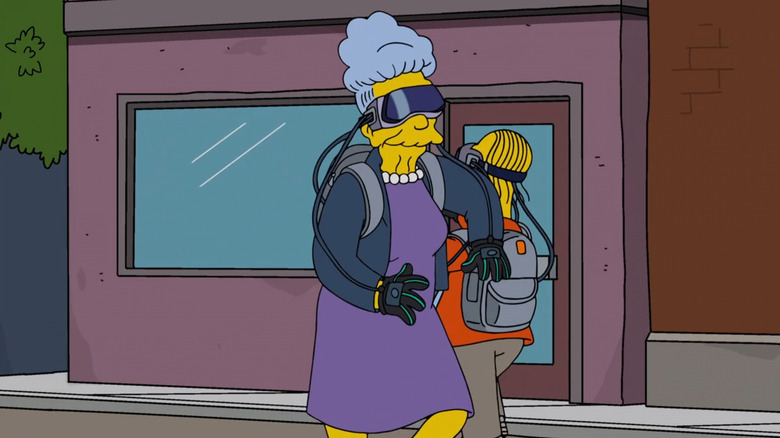We may receive a commission on purchases made from links.
It’s a well-worn meme at this point that the writing staff of “The Simpsons” must be time travelers with all the things they’ve managed to predict over the years. From Donald Trump’s presidency to Disney buying out 20th Century Fox, things that are played for simple gags on the animated sitcom end up eerily coming to fruition.
Advertisement
Of course, there’s a perfectly reasonable explanation for why “The Simpsons” is able to do this. The show’s been on the air for decades, with hundreds of episodes, so it’s bound to get something right now and then. Add in the fact the show regularly dabbles in social satire, poking fun at things that are relevant at the time, and it only makes sense that history would wind up repeating itself to where it looks like the show was super prescient. Still, it’s impressive to watch all the same, especially when it comes to how much advanced technology has been featured on the show years ago only to actually come out years later.
Certain devices, like smartwatches, were bound to come out one way or another, but it’s far more humorous when something like a baby translator ends up being made — sort of. Here’s all the cool tech “The Simpsons” featured years before it was a reality. Consider it an incentive to check in with newer episodes of “The Simpsons” to see what society might get 20 years from now.
Advertisement
The Yard Work Simulator became FarmVille
On “The Simpsons” Season 9, Episode 12 — “Bart Carny” – Marge tries to get the kids to do some yard work. She’s disappointed when they refuse, but Homer, as his usual oblivious self, ends up taking them all to the carnival anyways. Once there, they want to go on all fun rides, with Bart expressing his enthusiasm over trying the “Yard Work Simulator,” despite his reluctance to perform any actual yard work earlier.
Advertisement
The joke is clear — kids don’t want to do anything productive, but they’ll jump at the chance to perform manual labor if it’s presented as a cool video game. That’s pretty much the ideology behind “FarmVille,” the Facebook game that took the world by storm in the 2010s. People could log on to plant crops and raise livestock, with the main feature being that your Facebook friends could visit your farm to help you out. It sounds like a lot of time and energy when one could learn actual skills like planting their own garden to become a little more self-sufficient in real life.
Sadly, all that time invested into “FarmVille” was all for naught when the game shut down for good at the end of 2020. In a way, “The Simpsons” joke could be seen as predicting the prevalence of all sorts of mundane video game simulators, such as “Car Wash Simulator” and “PowerWash Simulator.” At the very least, perhaps these simulators show people how fun and rewarding it can be to do these tasks in real life.
Advertisement
The Simpsons predicts smartwatches
When it comes to “The Simpsons” predictions, the Holy Grail remains the Donald Trump premonition in Season 11’s “Bart to the Future.” This is just a throwaway line in a flash forward episode showing Lisa as President of the United States, but before that, “The Simpsons” had a different peek into the future with Season 6’s “Lisa’s Wedding.” It sees Lisa almost getting married to her first love, Hugh Parkfield. When his first attempt at a proposal goes wrong, he immediately speaks into a phone located on his wrist.
Advertisement
It’s easy to see this as a precursor to modern smartwatches where people can make calls and keep track of all sorts of important data right from their wrist. Of course, real-world smartwatches simply have little screens instead of flipping open like an old-fashioned phone, but Hugh’s gadget does exude a certain old-school charm.
To be fair, there’s a long line of media predicting smartwatches before even “The Simpsons” was around. Arguably, the first well-known example came in the 1940s with “Dick Tracy” comics, with the titular character sporting a two-way radio on his wrist. “The Jetsons” and “Star Trek” followed suit, and there’s the real-world forefather to smartwatches with the Hamilton Pulsar Time Computer. This device, which looks super futuristic and featured an LED display, came out all the way back in 1972. Hugh’s smartwatch almost seems crude by comparison.
Advertisement
Video calling continues making things awkward
“Lisa’s Wedding” actually has quite a few technological predictions that were supposed to come out in the far-off year of 2010 — in case you need to be reminded of how long “The Simpsons” has been airing. After Hugh proposes, Lisa calls Marge on a video phone to tell her the good news. Much like Hugh’s smartwatch featuring a flip phone, the video calling device has some old-school sensibilities, such as how you still need to input a number using a rotary dial.
Advertisement
Still, it manages to predict how people could call one another and actually see who they’re speaking with. It wouldn’t take too long for this technology to appear, as smartphones with front-facing camera began making waves in the late 2000s. It’s not bad for a TV episode that came out in 1995. However, the technology became far more commonplace with the introduction of the iPhone 4, which came with FaceTime, allowing even more people to partake in this futuristic novelty. In fact, FaceTime came out in – 2010? Okay, are we sure “The Simpsons” writers aren’t actually time travelers with this one?
The video conferencing scene on “Lisa’s Wedding” is even more humorous with Marge not realizing she’s on a video call, like crossing her fingers when promising Homer won’t ruin Lisa’s big day. Anyone who’s ever had an awkward conversation with a parent who didn’t quite understand these newfangled gadgets can surely relate.
Advertisement
Robot librarians slowly taking over
“The Simpsons” certainly didn’t invent robots, and society has been hard at work trying to create these mechanical entities. Sometimes, this leads to useful inventions, but other times, it leads to some truly haunting robots getting put out into the world. In “Lisa’s Wedding,” the robots featured here — not counting the tin men seen toward the beginning — include a librarian whose face catches fire after crying.
Advertisement
Roboticists may be hard at work creating more realistic humanoid robots, but we already have librarian robots to a degree. In 2016, the introduction of a robot named AuRoSS, which was developed by Singapore’s Agency for Science, Technology and Research, was widely reported on. It’s an autonomous device that’s capable of scanning the myriad bookshelves to find any pieces that are out of place. After doing the rounds, it can then inform the librarian staff of which books need to be moved manually.
AuRoSS definitely can’t do everything librarians do, but it helps take the busywork out of a more menial task. AuRoSS also can’t cry when you remind it that it’s just a robot, but that’s probably for the best.
Advertisement
Simpsons had 3D-printed food first
Season 16’s “Future-Drama,” yet another peek into what could happen if the Simpson family ever aged, sees Bart and Lisa graduating high school. Marge takes a picture of the two before they go to prom, only for the photo to expand into a cake. Marge then exclaims, “It’s so great. We can do anything now that scientists have invented magic.”
Advertisement
To explain this phenomenon in the real world, one could argue Marge making that cake through the process of 3D printing. Researchers have been trying to develop viable means of creating food, such as using food inks that preserve the nutrition and flavor of frozen and fresh vegetables. This relies on piping an edible paste into whatever structure the user wants, and it could be a great way to ensure individuals get the nutritional requirements they need. Unfortunately, the technology is still pretty expensive for in-home use, and it’s not quite as easy as just taking a picture of whatever you want plastered on a cake.
“Future-Drama” definitely has some more outlandish future technology compared to something like “Lisa’s Wedding,” which looks downright grounded by comparison. Chief Wiggum has gone full RoboCop and Moe has a clone. Still, bioengineered food is within the realm of possibility — even if it’s not exactly magic.
Advertisement
The Simpsons get a smart house before it’s cool
It often takes a more far-out framing device to see “The Simpsons” dabble with new technology. “Treehouse of Horror XII” includes a segment where the family gets a new smart home, tricked out by a nefarious AI voiced by Pierce Brosnan. It does everything for them, from cooking their favorite foods to cleaning the dinner table. Of course, the AI also falls in love with Marge and tries to kill Homer, but before that, it shows off some pretty nifty technology.
Advertisement
Most people probably aren’t giving their homes full chrome makeovers, but plenty of high-tech gadgets make it easier than ever to have a smart home of your very own. Much like the Simpsons family, you don’t even need to be that rich, seeing as there are many affordable smart home devices to choose from. Ring Video Doorbells allow you to see who’s at the front door before answering, smart thermostats allow you to control your house’s inner temperature even when you’re away. Plus, smart vacuums clean your house autonomously, which comes in handy even if it can’t really help you clean the table after a meal.
The Brosnan-voiced AI — which borrows heavily from HAL 9000 from “2001: A Space Odyssey” — even exemplifies many people’s fears surrounding AI. Granted, the only human he wants to kill is Homer, but what if a highly advanced intelligence wanted something more than just marrying Marge?
Advertisement
Herb Powell paved the way for baby translators
On Season 2 of “The Simpsons,” we learn Homer has a half-brother named Herb, who is voiced by Danny DeVito. He’s a successful businessman who loses his fortune by the end of the episode due to Homer’s incompetence. Fortunately, he gets redemption in Season 3’s “Brother Can You Spare Two Dimes” when he borrows money from Homer for a gadget that’ll put him back on top — a baby translator. Maggie Simpson makes for the perfect test subject, as he analyzes her coos to figure out what she’s really trying to say.
Advertisement
No doubt an actual baby translator would be a major asset to new parents who just want their child to stop fussing. In the modern AI era, there are numerous services that market the ability to translate a baby’s cries into understandable demands. For example, the Cappella app states how it uses AI to translate a baby’s cries to determine if they’re hungry or sleepy. The app claims to be 95% accurate, but with membership costing $9.99/month, it’s natural if parents are skeptical of whether it’ll actually help them raise their kids. Similar apps include Nanny AI and ChatterBaby.
Herb becomes rich through his invention, although he becomes broke again later in the series, so the money clearly dried up somehow. Maybe there was some kind of flaw in his baby translator that resulted in massive recalls. Or perhaps the general population got tired of hearing Herb’s voice whenever their babies wanted to talk.
Advertisement
Thank heavens we didn’t quite get Homer’s hand-free camera
Gone are the days when people need bulky cameras when they can capture solid footage and photos on just about any smartphone. Today, it’s quite common for drivers to install cameras on their dashboards in the event of a car accident and for homeowners to put up video doorbells that monitor the outside of the home. Either way, the wide availability of hands-free cameras today makes people’s lives easier in more ways than one.
Advertisement
This idea of hands-free cameras can be seen in an episode of the “The Simpsons” called “Homer and Apu.” Homer is tasked with capturing Apu’s negligence on camera with a device so small it fits inside an oversized novelty hat. Of course, this camera is still huge, but Kent Brockman’s news team manages to get the footage wirelessly. It’s the kind of joke that only works in the context of the mid-’90s, as nowadays, Homer could’ve just clipped something to his shirt to prove that Apu sells dangerously expired food.
Today, hands-free cameras are an asset even when you’re not trying to narc on a small business owner. There’s even an iPhone hack where you can turn it into a hands-free camera for greater accessibility.
Advertisement
Professor Frink’s sarcasm detector comes to life
On Season 10, Episode 22 — “They Saved Lisa’s Brain” – Lisa meets up with the smartest people in Springfield, and eventually, they’re put in charge of running the town. Among them is Professor Frink, who frequently has all sorts of neat inventions to factor into the plot. At one point, he pulls out a sarcasm detector, although when it is confronted by the frequently sardonic Comic Book Guy, the device soon explodes due to a sarcasm overload.
Advertisement
One would assume picking up sarcasm would be fairly simple in day-to-day conversations, but researchers have actually come out with an AI-powered sarcasm detector. The University of Groningen’s Matt Coler told The Guardian, “When you start studying sarcasm, you become hyper-aware of the extent to which we use it as part of our normal mode of communication. But we have to speak to our devices in a very literal way, as if we’re talking to a robot, because we are. It doesn’t have to be this way.”
Ultimately, the application seems to mostly apply to humans speaking with AI models, which may be more inclined to take everything literally. There’s really no need to use it on someone who’s sarcastic in virtually every conversation like Comic Book Guy. Hopefully, this doesn’t lead to people taking a bunch of bad advice from AI because it starts deciding to be sarcastic.
Advertisement
Springfield gets the Apple Vision Pro first
The history of practical VR goes back decades, usually involving people wearing some kind of goggle-esque headset to see things that aren’t really there. “The Simpsons” certainly didn’t invent the aesthetic, but it’s hard not to see similarities between the VR headsets featured in Season 28’s “Friends and Family” and the Apple Vision Pro, which would come out eight years after the episode.
Advertisement
Much of the episode centers on Mr. Burns acquiring a VR headset and using the Simpson family — minus Homer, that is — to create idyllic family scenes since he never had a family of his own. However, the most relatable scene from the episode likely comes at the end when everyone in Springfield is seemingly using the headsets as they go about their day. This often results in catastrophe, like when Agnes Skinner falls down a manhole.
The Apple Vision Pro, despite having a Travel Mode, isn’t really meant to be used outside, despite the presence of videos of people using them out in public. One of the biggest complaints of the Apple Vision Pro is the narrow field of vision compared to competitors like the Meta Quest 3. It poses many dangers, so it might appear that in addition to “The Simpsons” predicting the Apple Vision Pro, it also anticipated its major drawback. Perhaps that’s the source of “The Simpsons” being able to predict so much — no matter what technology gets invented, people will find the most hilarious way to misuse it.
Advertisement
This post was originally published on here


